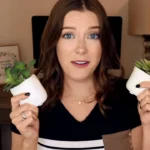Ingestion, Stomach Pain, Vomiting: Betta fish might try to nibble on plastic plants out of curiosity or mistaken them for food. Ingesting plastic pieces can lead to internal blockages, stomach pain, or even vomiting. Since betta fish cannot vomit in the traditional sense, ingested plastic can cause severe digestive issues or even be fatal.
A densely planted tank with plastic plants can restrict a betta’s movement, causing stress or physical harm. Sharp edges or rough surfaces on plastic plants can scratch or tear the delicate fins and skin of a betta fish, leading to infections or diseases.
Betta fish have delicate fins that can easily be torn or damaged when they swim too close to or brush against these sharp edges.
Common Aquarium Plants: Live plants like Anubias, Java Fern, and Amazon Sword are popular choices. They provide a natural environment and benefits such as oxygenation and filtration.
Plastic aquarium plants are usually made from soft plastics or silicone to minimize the risk of injury. However, cheap or low-quality plastic plants can have sharp edges or shed small particles that might be harmful if ingested.
Betta Fish Specific Plant Choice: Betta fish do prefer specific types of plants. They thrive in environments with plants like Java Fern, Hornwort, and Water Wisteria that offer broad leaves or dense foliage for hiding and resting.
Overcrowding an aquarium with plants and decorations can affect water quality and flow, potentially leading to oxygen depletion. Bettas need access to the water’s surface to breathe air due to their labyrinth organ. Insufficient space or blocked access to the surface can cause breathing difficulties.
- Safe Decorations: Caves, tunnels, and smooth, rounded rocks are safe and enrich the habitat. Ensure decorations don’t have sharp edges or small, detachable parts.
- Potential Harm: Decorations with sharp edges can injure bettas. Materials that alter water chemistry or leach toxic substances can be harmful.
- Ornaments as Decorations:
- Toxicity and Risks: Ornaments made specifically for aquariums are generally safe, but non-aquarium-specific decorations may leach harmful chemicals. Broken ornaments can pose a significant risk if betta fish ingest sharp fragments, leading to internal injuries or blockages.
- Safe Live Plants:
- Safe Options: Anubias, Java Fern, Marimo Moss Balls, Cryptocoryne, and Amazon Sword are excellent choices. They’re safe for bettas, help improve water quality, and provide natural hiding spots.
Choose silk plants or live plants instead of plastic ones. Silk plants are softer and less likely to cause physical harm to your betta, and live plants can improve water quality and provide a more natural environment.
If you prefer to use plastic plants, carefully inspect them for sharp edges or points before placing them in the tank, and consider filing down any sharp edges.
Regularly monitor your fish for signs of stress or injury and the plants for signs of degradation or chemical leaching.
Silk “Betta-Safe” Plants
Silk plants offer a safer alternative to live plants and hard plastic plants, which can sometimes have sharp edges that could harm bettas. “Betta-Safe” silk plants are specifically designed to be soft and gentle on the fins of a betta fish. These plants often come with a base that can be buried under gravel to anchor them securely in the tank. The fabric of these plants is designed to mimic the natural movement and texture of live plants, providing bettas with a comfortable and stimulating environment. It’s important, however, to inspect these plants for any exposed wires or signs of rusting over time, as they could harm the fish.
Anacharis
Anacharis, Egeria densa, also known as Elodea or Brazilian Waterweed, is a popular aquatic plant that thrives in a wide range of conditions, making it ideal for betta tanks. This plant can be grown in two ways: rooted in gravel or left to float freely. When planted in gravel, it provides a rooted landscape that bettas love to explore and can also help with hiding spots and territories. As a floating plant, it offers shelter and reduces stress for bettas by dimming the lighting and creating a more natural environment. Anacharis is highly beneficial for the aquarium’s ecosystem; it absorbs nutrients from the water, which can help control algae growth and improve water quality. This plant is relatively easy to care for, requiring moderate to bright light and can adapt to a wide range of temperatures, which aligns well with the warm waters preferred by bettas.
Oxygenation: Through photosynthesis, it releases oxygen into the water, improving the overall water quality and aiding in the respiratory health of your fish.
Care Tips:
- Lighting: Prefers moderate to high light levels.
- Water Temperature: Thrives in a wide range, but ideally between 72°F and 78°F, which suits bettas well.
- Trimming: Since it grows quickly, regular trimming may be necessary to prevent it from overtaking the tank.
Cabomba or Carolina Fanwort
Cabomba, also known as Carolina Fanwort, is a feathery, fan-shaped aquatic plant that is highly appreciated in betta tanks for its dense foliage and natural hiding spaces for fish. To successfully grow Cabomba, it’s usually anchored in gravel or substrate at the bottom of the tank. This plant requires a bit of care, including adequate lighting and clean water, to thrive. Its delicate leaves can create a beautiful, soft underwater landscape that not only beautifies the tank but also provides bettas with excellent cover and resting areas. The dense foliage of Cabomba can help mimic the natural habitat of bettas, encouraging their natural behaviors and providing a sense of security.
Care Tips:
- Lighting: Requires moderate to high lighting to thrive.
- Water Conditions: Prefers slightly acidic to neutral pH and a temperature range suitable for bettas.
- Trimming: Regular trimming helps maintain its shape and prevent it from shading lower plants.
Betta fish are curious creatures that enjoy exploring their surroundings. Plastic plants can provide excellent hideaways, helping bettas feel secure.
Many plastic plants come with suction cups to anchor them to the tank’s bottom or sides. Ensure these are firmly attached to prevent them from coming loose and startling your betta. Betta “hammocks” are special leaves positioned near the water surface, allowing bettas to rest near their preferred bubble nest area.
Regular maintenance, including the removal of plastic plants for cleaning, is essential to prevent the buildup of harmful substances. While these roots don’t contribute to water filtration like live plant roots do, keeping them clean is crucial for a healthy tank environment.
Consider integrating live plants like duckweed, Salvinia, frogbit, and Java moss, which can enhance water quality and provide natural hiding spots. These plants also do not impede swimming or cause fin trauma. Live plants can contribute to the stability of bubble nests by providing additional structure.
The size and shape of the plastic plants should be appropriate for your tank to avoid overcrowding and impeding your betta’s swimming. Be wary of plants with exposed roots or branches that could catch or tear fins. Instead, select plants with soft stems or those specifically designed for betta safety. Tools like nail clippers can be used to trim any sharp parts on the plastic plants or to adjust their size for your tank.
Live floating plants like duckweed, Salvinia, and frogbit not only compete with algae by consuming nutrients but also provide natural cover and can enhance the stability of bubble nests constructed by betta males.
It’s crucial to quarantine new plastic decorations before introducing them to the tank to avoid contaminating the water with chemicals or pathogens.
When using live plants, liquid aquarium plant fertilizer can promote healthy growth but should be used as directed to prevent adverse effects on water quality.
Betta “Hammocks”
Betta “hammocks” are specially designed resting places for betta fish. These leaf-shaped (suction cup) devices stick to the aquarium glass, providing a place for bettas to rest near the surface of the water. While these hammocks are often made with betta safety in mind, the concern with plastic plants is slightly different.
Bubble Nests
Bubble nests are created by male betta fish as a part of their breeding behavior. These nests are made of bubbles produced by the betta and often stuck to the surface of water plants or decorations. The presence of bubble nests is a sign of a healthy and comfortable betta. However, when incorporating plastic plants or any decorations, it’s vital to ensure they don’t disrupt the surface tension of the water too much or make it difficult for the betta to maintain its bubble nest.
“Fin Rot”
“Fin rot” is a common ailment among betta fish, often caused by poor water quality or stress, which can be exacerbated by injuries from their environment. Sharp or rough edges on plastic plants can create small tears in a betta’s fins, serving as entry points for bacteria and fungi that cause fin rot.


